Great ad copywriting can be the difference between a customer taking action on your offer or scrolling down to the next thing that catches their eye.
Most copywriters have a collection of memorable ads they can turn to for ideas.
In this post, we’ll share 16 examples of ad copy that illustrate key approaches for success. Once you apply these copywriting techniques, you’ll create ads that draw attention, get clicks, and potentially convert.
1. Liquid Death: Speak Your Audience’s Language
When you speak your audience’s language, you connect with them on a deeper level. So they feel like they found a brand that understands them.
Liquid Death is a great example of this. And proof that even if the product you’re selling is mundane, your branding and advertising don’t have to be.
The company mainly sells packaged water. It admirably does so in cans, its mission being to “kill plastic pollution.” But rather than focus on the beverage’s hydrating properties or natural sourcing like other brands, it leans into its heavy metal aesthetic.
Liquid Death’s marketing strategy targets a specific audience: young people who know the health benefits of water but find it dull.
And its Facebook ad copy makes its position loud and clear: “Proudly not for everyone.”
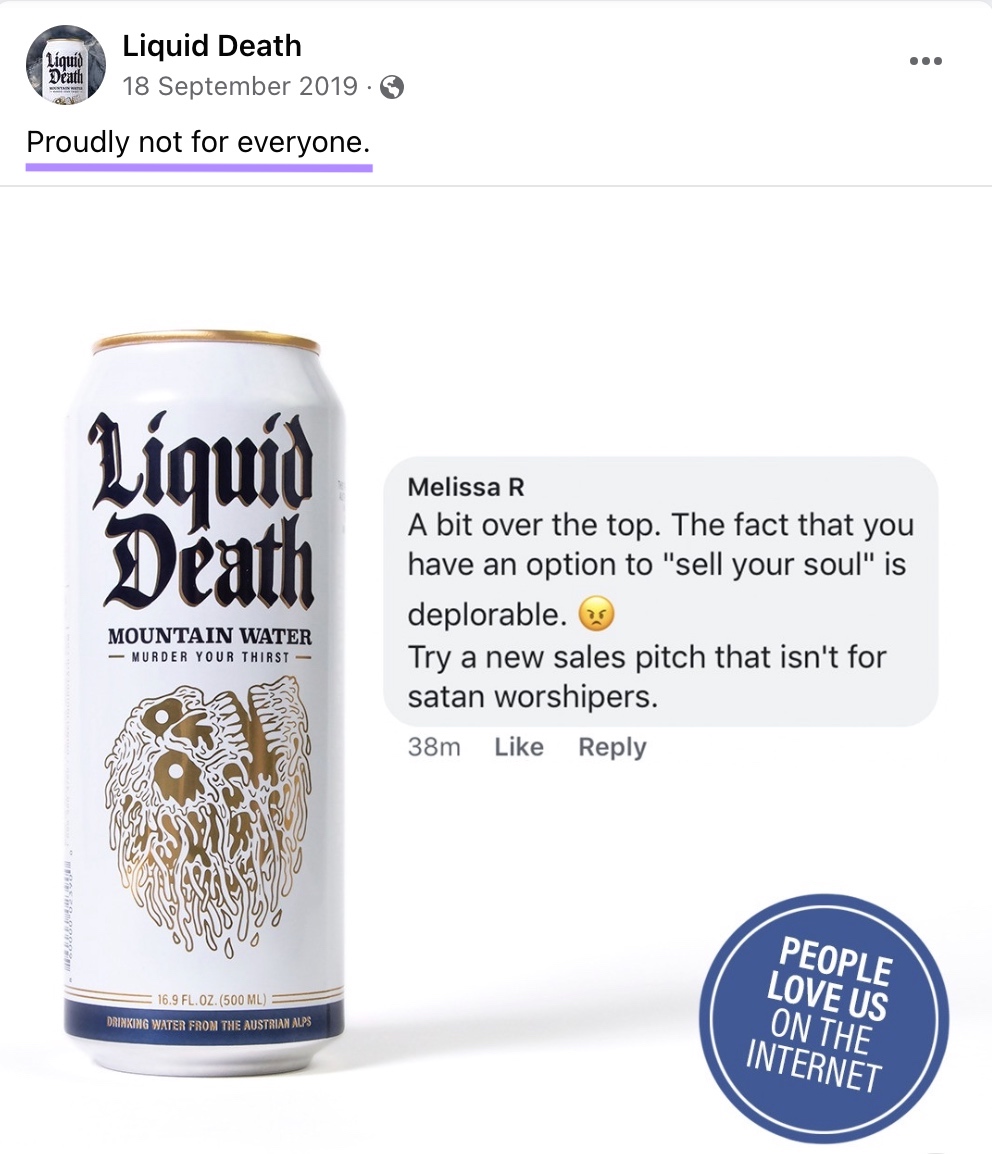
Adding a bad review brings home the point. And drives engagement.
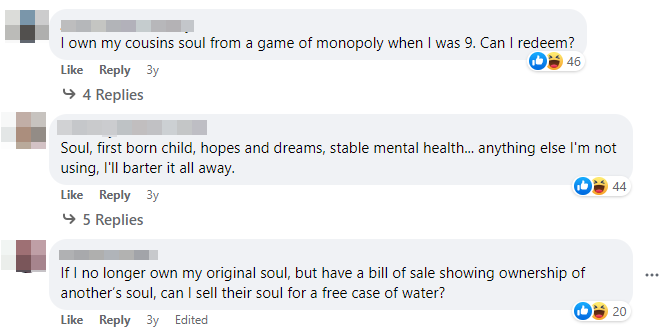
Liquid Death uses the same tone in its call to action (CTA):

What can you take away from this?
Two things:
- Not everyone is your audience. Find your target market and speak directly to them.
- Be prepared to alienate people. Have the courage to be disliked by some to strengthen relationships with others.
2. Blume: Challenge the Competition
How do you get someone to choose you over a competitor?
By showing them what you do better.
Coffee brand Blume’s unique selling point (USP) is superfoods. Its products don’t use refined sugar or syrups, making them a healthy choice for latte lovers.
Its Facebook ad challenges the competition without taking a direct shot at a particular brand.
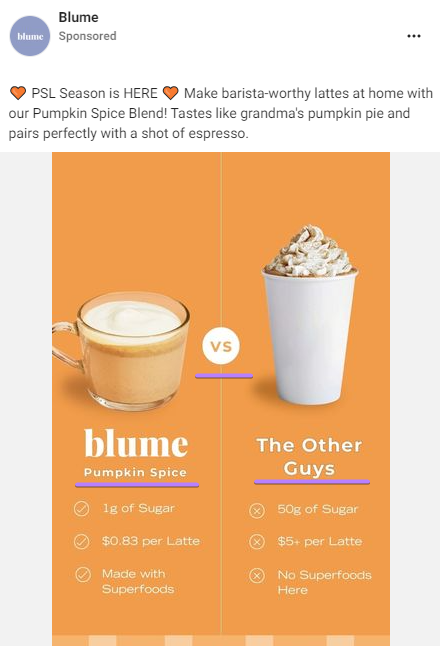
We all know who “The Other Guys” are.
To sell Blume’s product as the best option, the copy only has to compare stats.
The message is clear. Blume is healthier and cheaper than big brand alternatives.
The accompanying copy appeals to nostalgia. Blume’s Pumpkin Spice latte “Tastes like grandma’s pumpkin pie.”
It alludes to Blume giving you that home-made gastronomic experience, which is more warm and inviting than a drive-thru coffee.
3. Bic: Let Your Audience Use Their Imagination
Global company Bic manufactures products ranging from stationery to beauty to lighters. It’s EZ Reach lighter ad is the perfect example of knowing your audience and using intrigue to engage them.
It features businesswoman and TV personality Martha Stewart with rapper Snoop Dogg.
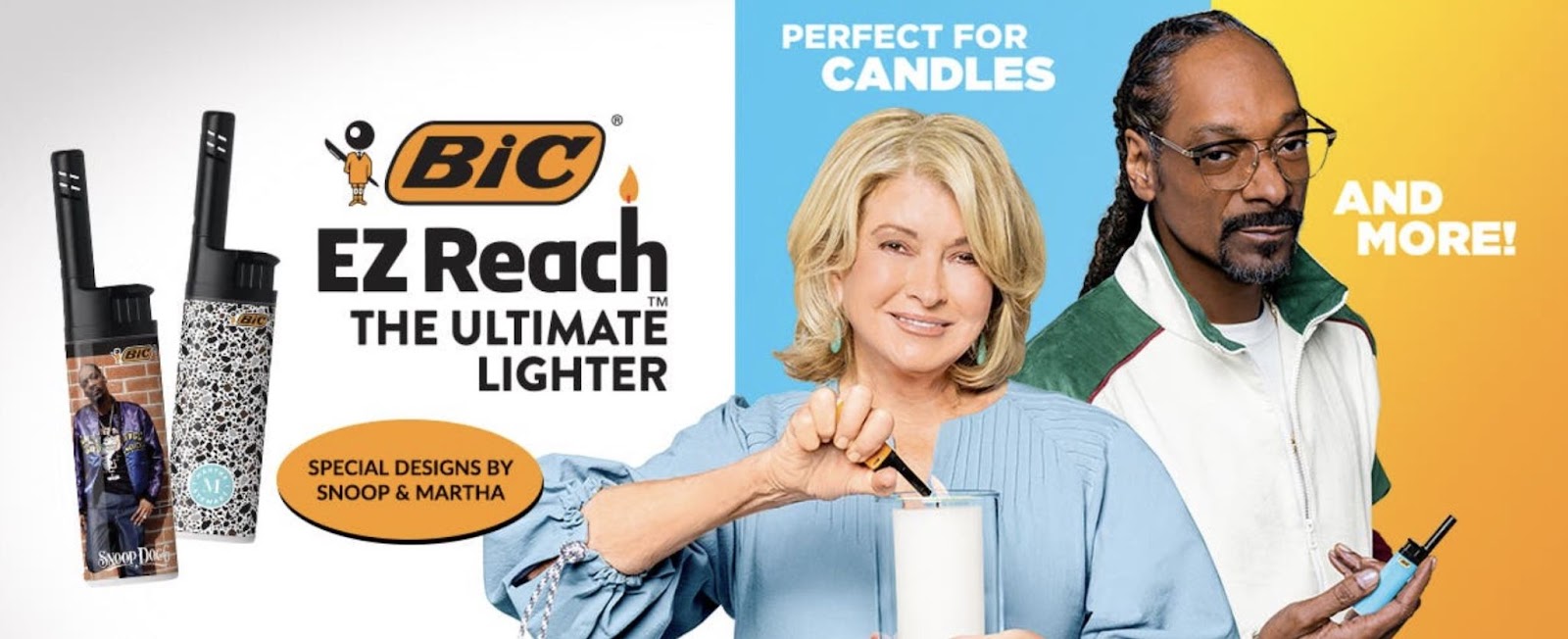
Martha Stewart is famous in the U.S. for (among other things) making and selling candles.
Snoop Dogg is a notorious smoker of various substances.
Bic lets the visuals do the heavy lifting. But the copy is clever.
Why?
Because it takes the audience most of the way there. But invites them to use their imagination:
“Perfect for candles. And more!”
When you connect those dots, the genius of the ad is clear. And Bic’s brand perception improves instantly.
Bic’s creative does what good stories do. It gives you—the consumer—a chance to inject your personality and be part of the discovery experience.
Apply the same approach to your copy. Trust your audience’s imagination. There’s magic in a little mystery—and it can make for a great ad.
4. Wix: Show Your Authority
Showing your authority helps give your brand status. It tells people you’re an expert and conveys credibility. And it’s an advantage when running Google Ads.
Why?
Because Google Ads puts you in direct competition with brands targeting the same keywords and the same potential customers.
So it’s no place for modesty.
Wix understands that. To build brand awareness and get clicks, it positions itself as the industry leader.
Do a Google search for “best website builder.” Wix shows up as the “#1 Website Builder” in the Sponsored Google Ads section of the search engine results page (SERP).
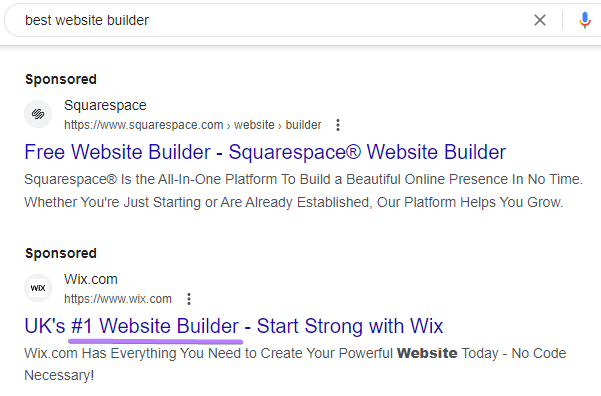
That claim gives Wix an edge over Squarespace, which has the ad above it.
Wix backs up its headline with supporting copy that includes power words to trigger excitement:
- Everything You Need to Create Your Powerful Website Today
- No Code Necessary
Readers learn that Wix is the best place to build a professional website without web design experience.
Add words like “#1,” “best,” or “industry-leading” to your ad copy to show your authority. And put yourself ahead of the competition in the customer’s mind.
5. Huel: Solve a Pain Point
Solving a pain point means addressing a problem your customers experience. It tells people seeing your ad that you know their struggle and have the solution.
Huel is a good example of a brand that understands its audience’s needs.
It is a nutritionally complete plant-based food that makes it easy to maintain a healthy diet.
Its Instagram ad appeals to a key customer problem: It’s not easy to eat healthy when you’re short on time.
The succinct headline draws the audience in.
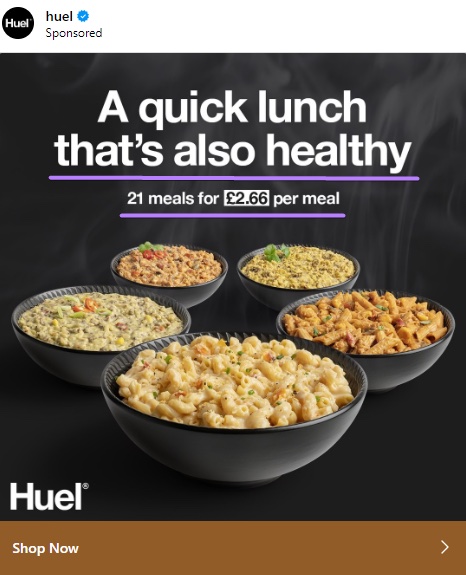
Then the caption hammers home the benefits.
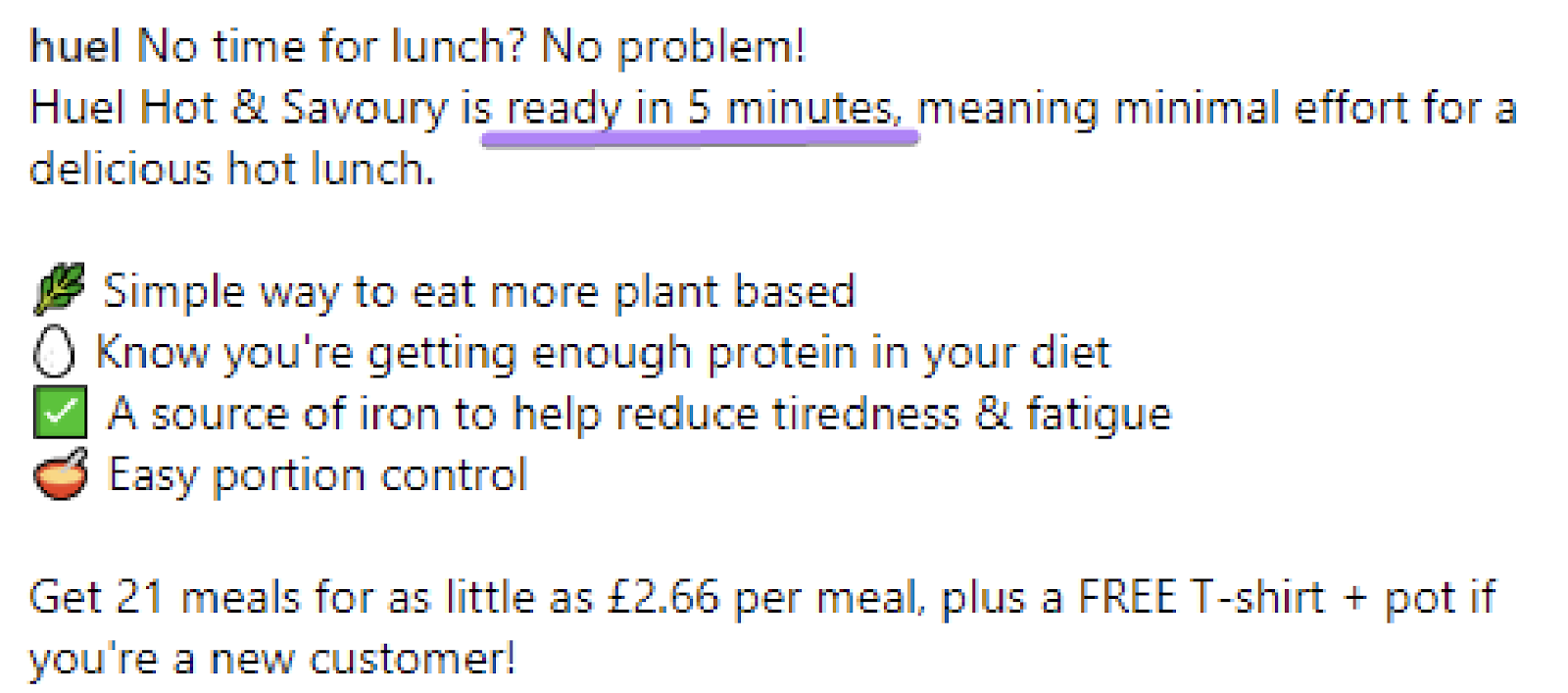
- Problem: I don’t have time to cook a healthy meal
- Solution: “Huel Hot & Savoury is ready in 5 minutes”
Emojis help draw the eye to key selling points. They tell readers that Huel is more nutritional than fast food alternatives. And won’t leave you feeling sluggish in the afternoon. Better still, it’s affordable.
The above ad shows that copy doesn’t have to be clever. It only has to get people to take action.
Research your audience. Ask questions about their behaviors, habits, and problems. Identify a pain point, then show how your product solves it.
Further reading: The Complete Guide to (Effective) Customer Analysis
6. MailerLite: Let Your Customers Do the Selling
Happy customers are your best sellers. 95% of customers read online reviews before buying a product, according to Brand Rated research.
Plus, a survey by Smart Money shows that 87% of people are most likely to trust reviews from other customers. Compare that to the number who trust industry experts (67%), professional reviewers (48%), and companies or brands (41%).
So it makes sense to utilize reviews in your advertising.
Take cloud-based email marketing solution MailerLite. Its LinkedIn ad is proof that sometimes, the best ad copy is already written.
Rather than come up with a catchy headline, MailerLite uses a customer testimonial as social proof to sell its product.
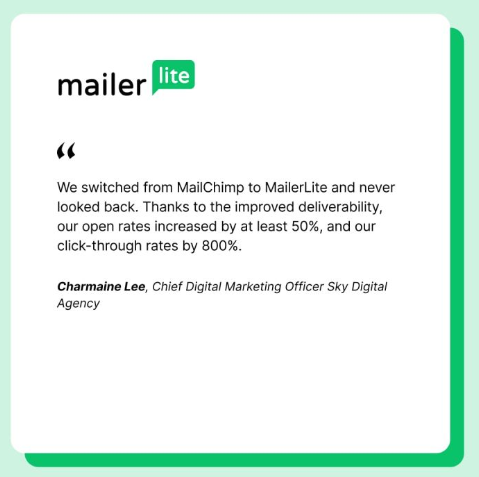
The review mentions switching from MailChimp. Which helps present MailerLite as the better option.
It backs this up with statistics: “...our open rates increased by at least 50%, and our click-through rates by 800%.”
Finally, the review is by a Chief Digital Marketing Officer at an established brand. That gives it authority. If someone in that position trusts MailerLite, it has to be worth a look.
If you’re struggling to come up with good ad copy, turn to your customers. Their words can be the most powerful selling tool you have.
7. Lord Leo the Lazy Pom: Show Your Authenticity
Being authentic in your ads is a quality that can help you stand out. Because while people are used to being advertised to, they’re skeptical of what they see.
Of 36,000 respondents in an Edelman trust survey, only 8% automatically believe what they see in ads to be true. Another 41% said they need to see the information repeated once or twice before assuming it’s true.
The takeaway? Ensure your ad copy reassures skeptics and instills a sense of trustworthiness.
Social media influencer Lord Leo the Lazy Pom has a refreshing approach to sponsored content that demonstrates authenticity.
Rather than add “#ad” to content that’s otherwise presented as organic, creator Nick Sheingold includes the word in his ad copy.
And he explains why Lord Leo the Lazy Pom is running the ad.
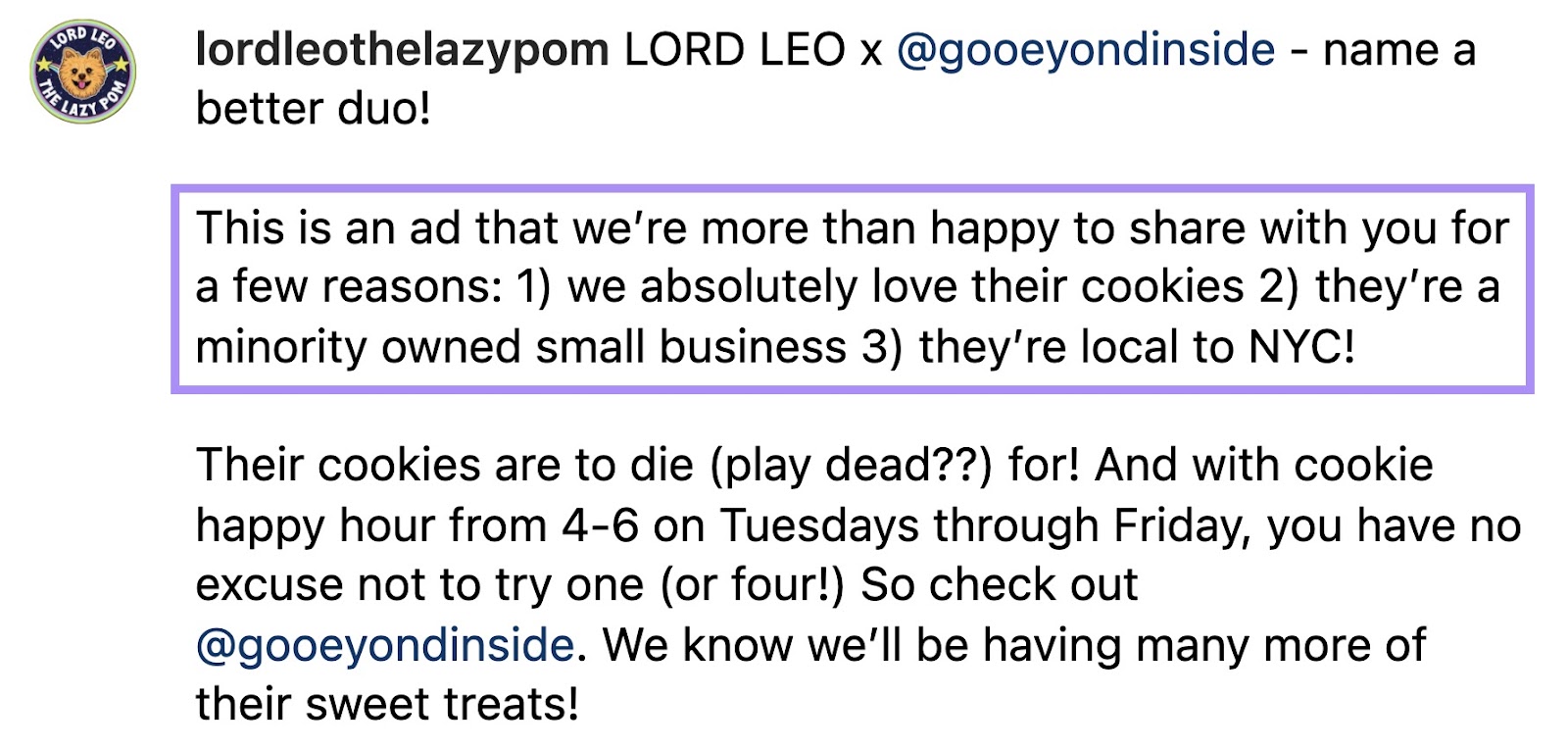
By owning the fact it’s an ad, Lord Leo The Lazy Pom creates trust and respect.
They’re not advertising something because it pays well. They’re supporting a product they believe in.
If you love a brand and back the product, say so. Embrace the fact it’s an ad. Audiences will appreciate that.
8. Earth Shoes: Share Your Purpose
Footwear brand Earth Shoes’ copy for its Facebook carousel ads doesn’t sell shoes. It sells what its shoes represent.
Why is that important?
Because customers are four to six times more likely to buy from, trust, and champion brands with a strong purpose.
By selling what it means to own a pair of Earth Shoes, the brand focuses on its competitive advantage.
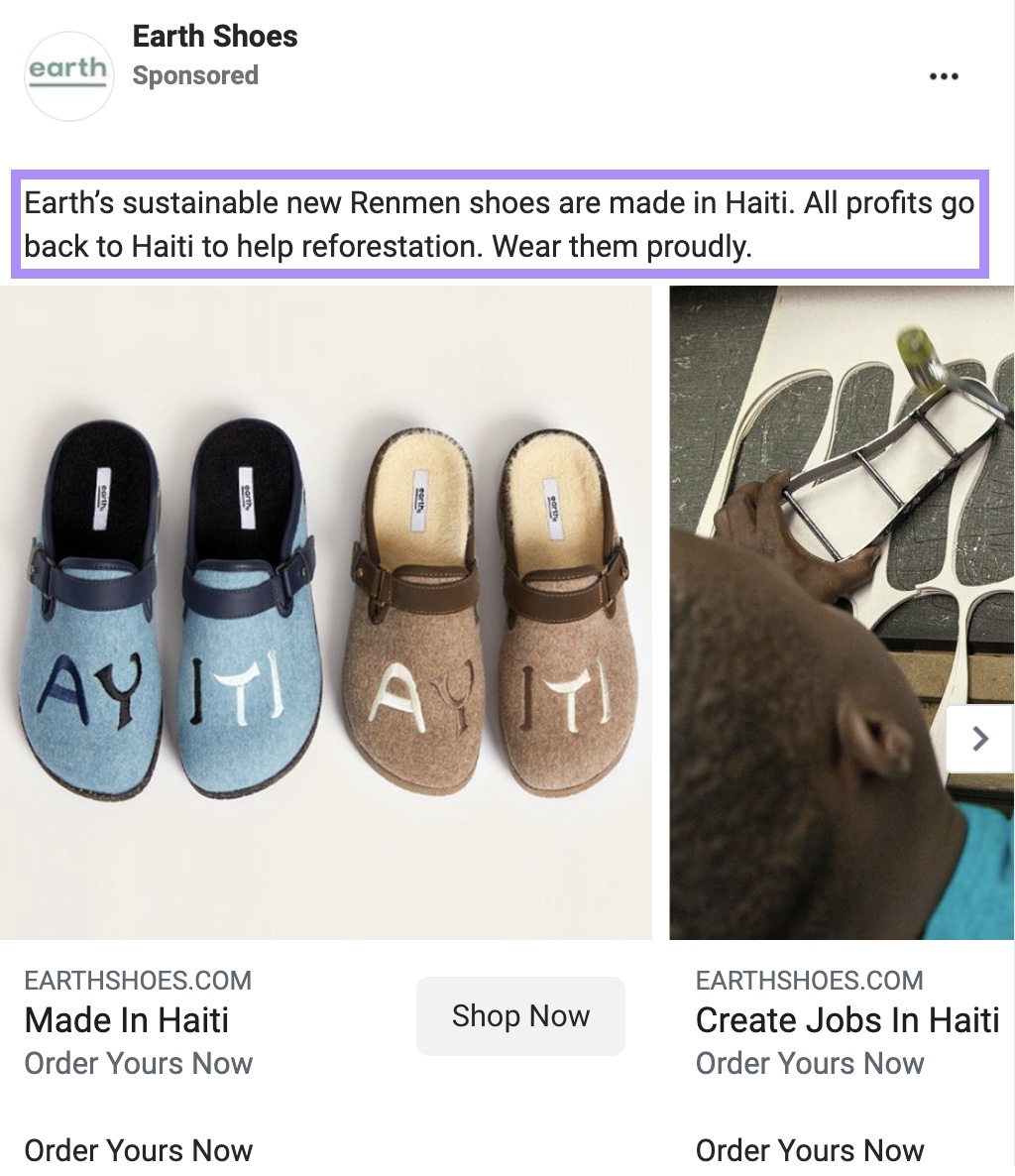
And uses copywriting to appeal to customers who value purpose.
Purchasing Earth Shoes means you’re buying a sustainable product. More importantly, you’re supporting a company that gives back.
It’s a subtle but powerful form of emotional advertising. Appeal to your audience’s sense of pride to make them feel good about themselves and your brand.
9. DuckDuckGo: Distill Your Benefit
Your core benefit is the one thing you do better than everyone else. Don’t be afraid to tell the world about it.
Web browser DuckDuckGo’s billboard ad is a high-quality example of finding this benefit and condensing it into a few words.
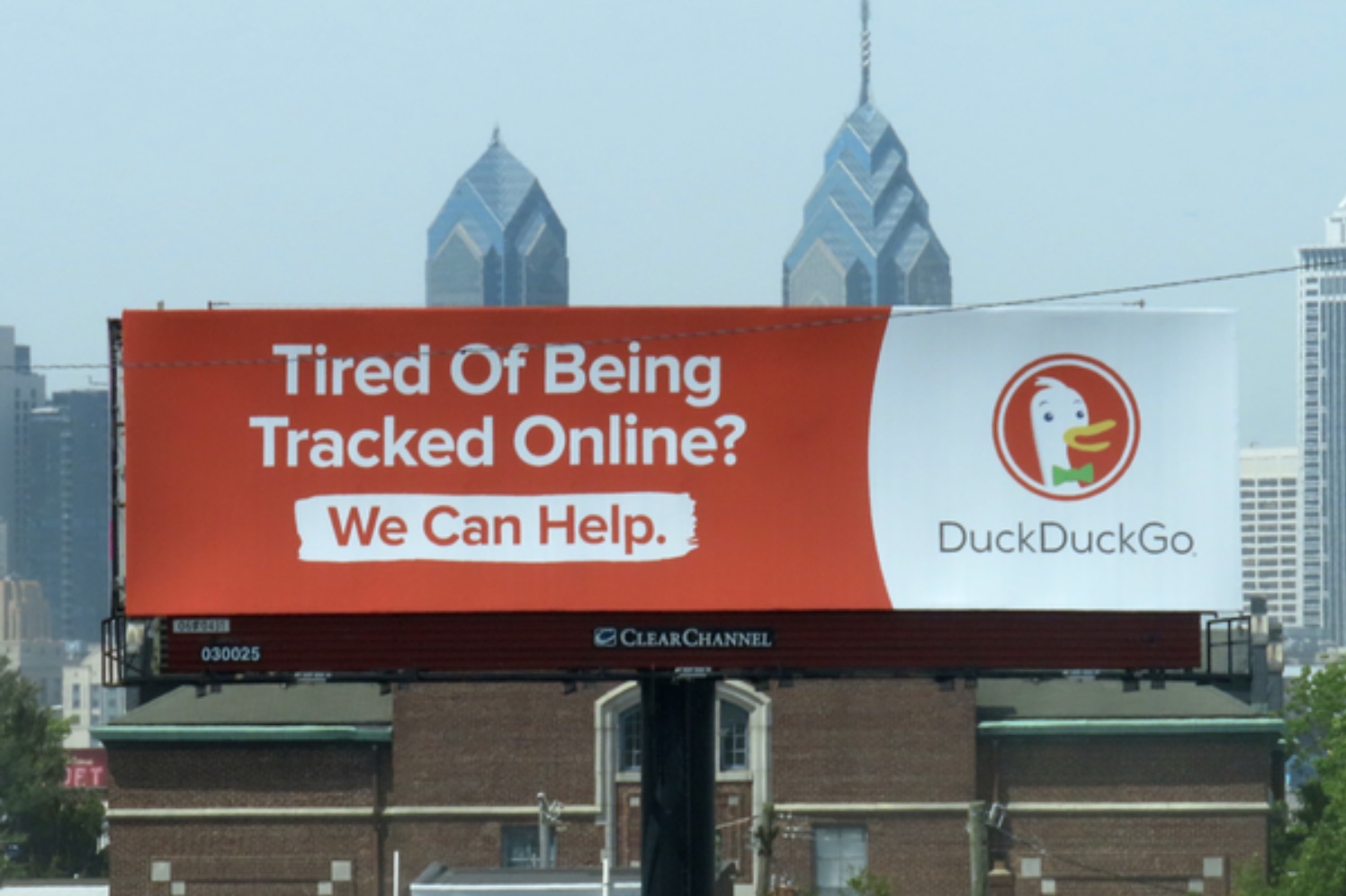
Why are some people wary of Google? Because it tracks your activity across its products and services.
How can we tempt these people over to DuckDuckGo? By easing their worries.
“Tired Of Being Tracked Online? We Can Help.”
Be straightforward in expressing your worth. As advertising executive Maurice Saatchi said:
Simplicity is all. Simple logic, simple arguments, simple visual images. If you can’t reduce your argument to a few crisp words and phrases, there’s something wrong with your argument.
10. QuickBooks: Use Search Intent to Inspire Your Copy
Search intent is the reason why a user types a query into a search engine. They may be looking for an answer to a question, a specific website, reviews for a certain product they’re interested in buying, etc.
Google Ads lets you run ads for specific keywords so you can target users based on their intent.
Accounting software brand QuickBooks does this brilliantly. Using relevant ad copy to get clicks.
Search Google for “Freshbooks alternative” and a QuickBooks ad shows up.
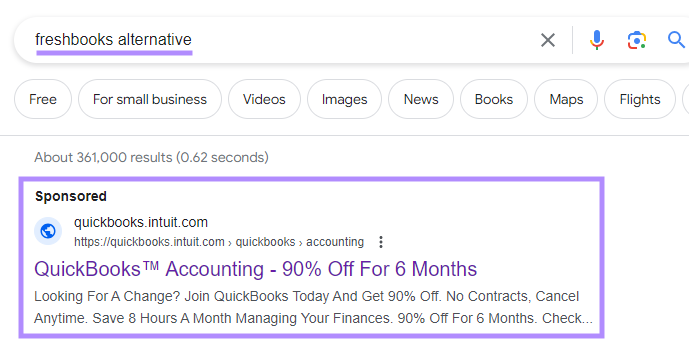
QuickBooks knows the user is investigating new products. It capitalizes on the high transactional intent with a cost-saving offer: “90% Off For 6 Months.”
The supporting copy also plays to intent effectively. QuickBooks adds further benefits to reduce buyer friction and make the offer more appealing:
- “No Contracts”
- “Cancel Anytime”
- “Save 8 Hours A Month”
Let search intent guide your search ad copy. Figure out what the customer wants and give them what they expect to see.
If you have an attractive deal or limited-time offer, use it when the searcher is ready to act. The right deal combined with the right intent gives you a good chance of conversion.
To find search intent for your pay-per-click (PPC) campaigns, type your keywords in Semrush’s Keyword Magic Tool.

Semrush considers the four main types of search intent:
- Navigational intent: When someone looks for a specific page
- Informational intent: Searchers want to learn more about a given topic
- Commercial intent: Users carry out research before making a purchase decision
- Transactional intent: The aim here is to complete a specific commercial transaction
The results in the tool will show you related keywords and the search intent for each.
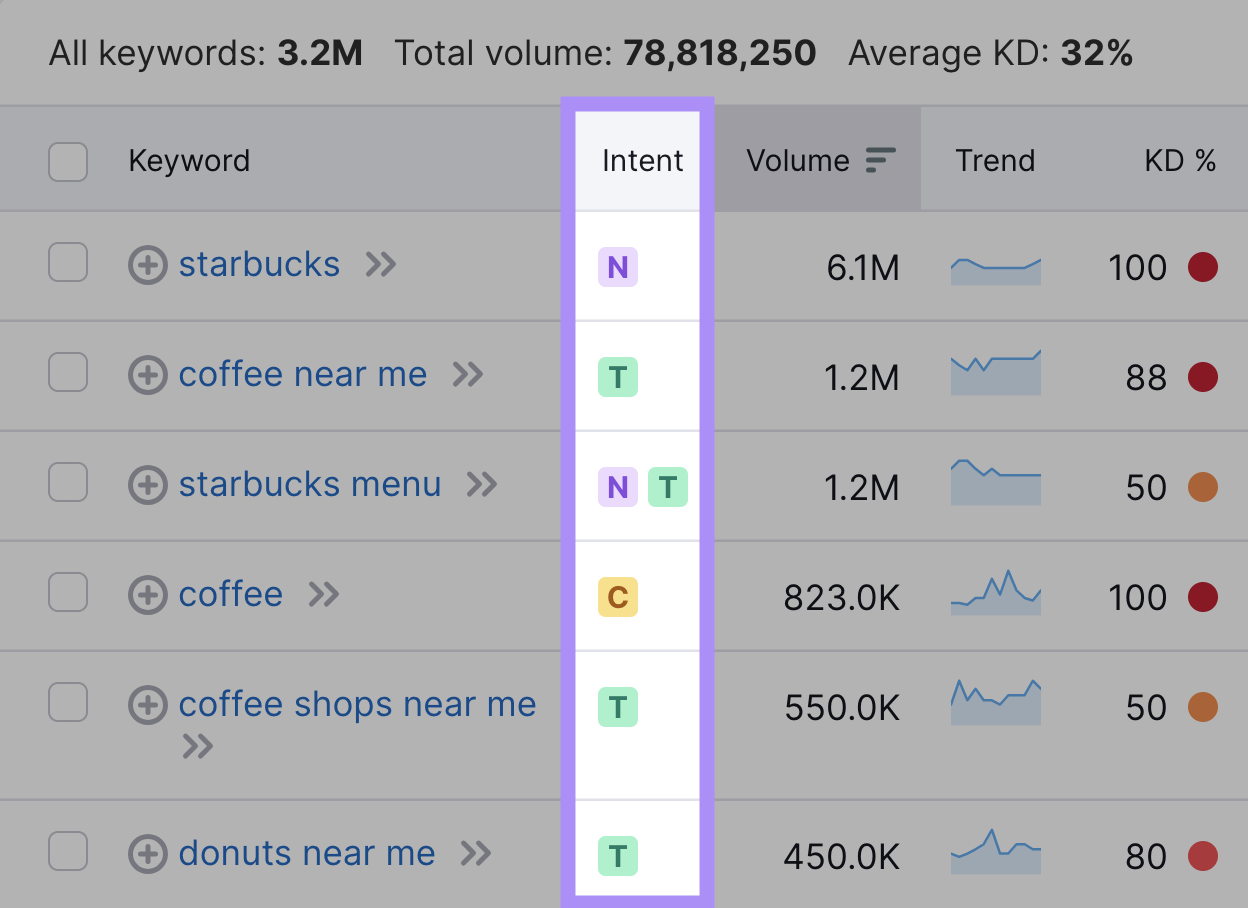
11. The Athletic: Tell Customers What You Aren’t
Sometimes, your most attractive value proposition is what you don’t have.
Appeal to your audience by emphasizing certain features you do away with to ensure a less complicated or stressful—and therefore more enjoyable—product experience.
For instance, sports site The Athletic uses the power of contrast to show readers why it’s the best choice.
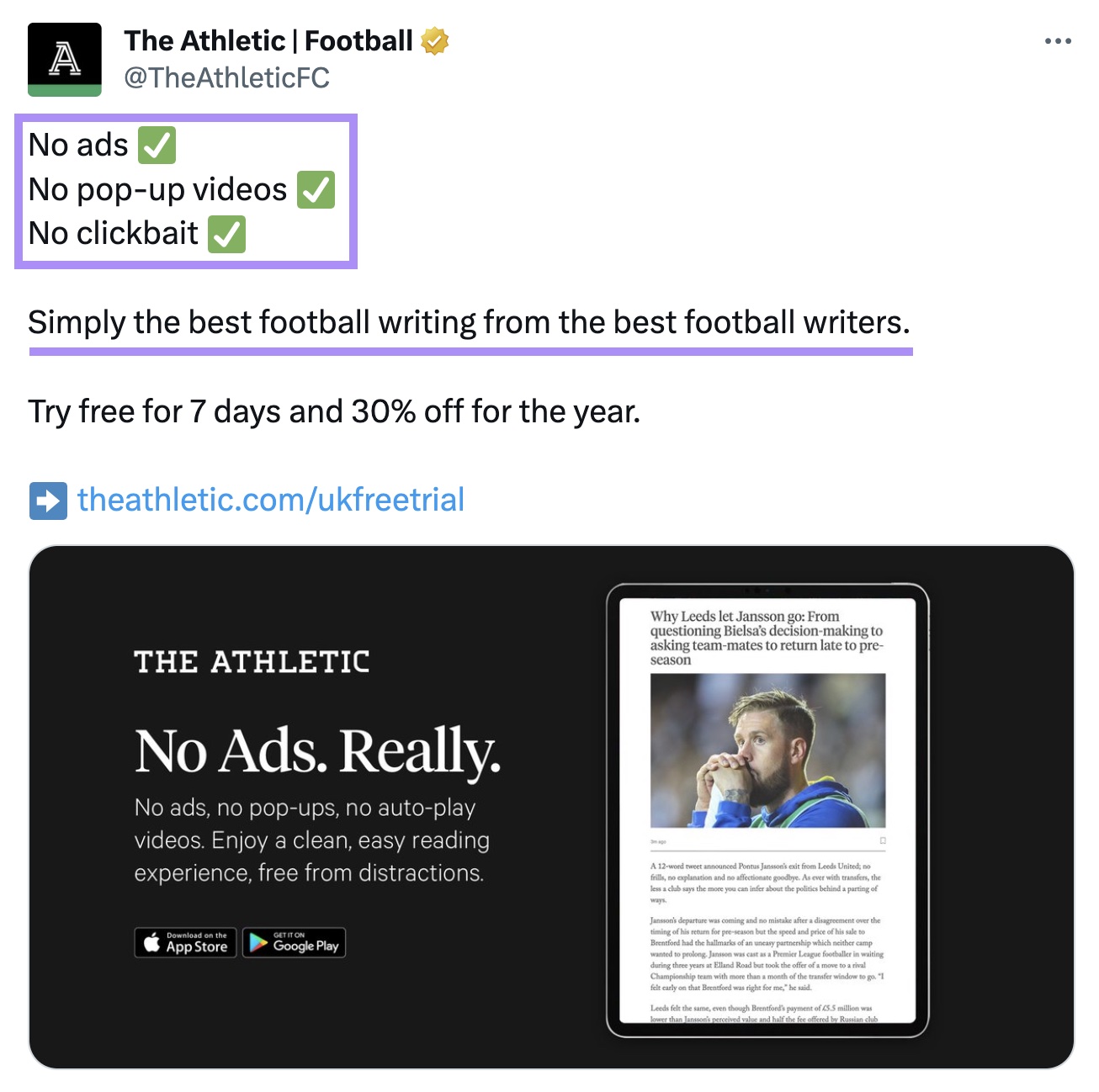
- What it isn’t: “ads,” “pop-up videos, “clickbait”
- What it is: “Simply the best football writing from the best football writers”
Identify and expose your competitor’s weaknesses to highlight your own strengths.
In the example above, The Athletic’s promises resonate with those who are used to news sites that disrupt the reading experience with multiple popups and ads.
The Athletic is helping its audience make the comparison without calling out any specific competitors.
Further reading: What Is a Competitor Analysis & How to Do It
12. Curio: Appeal to Your Audience’s Aspirations
By appealing to people’s aspirations, you show them what they can become. You’ll likely build lasting relationships and keep customers coming back for more.
Curio is a great example of aspiration-led ad copy.
The app turns handpicked content from leading publications into narrated audio. To keep users informed about current affairs.
Its copy is an example of a classic sales technique: Sell the benefits, not the features.
In other words, push the outcome of the product rather than the actual item.
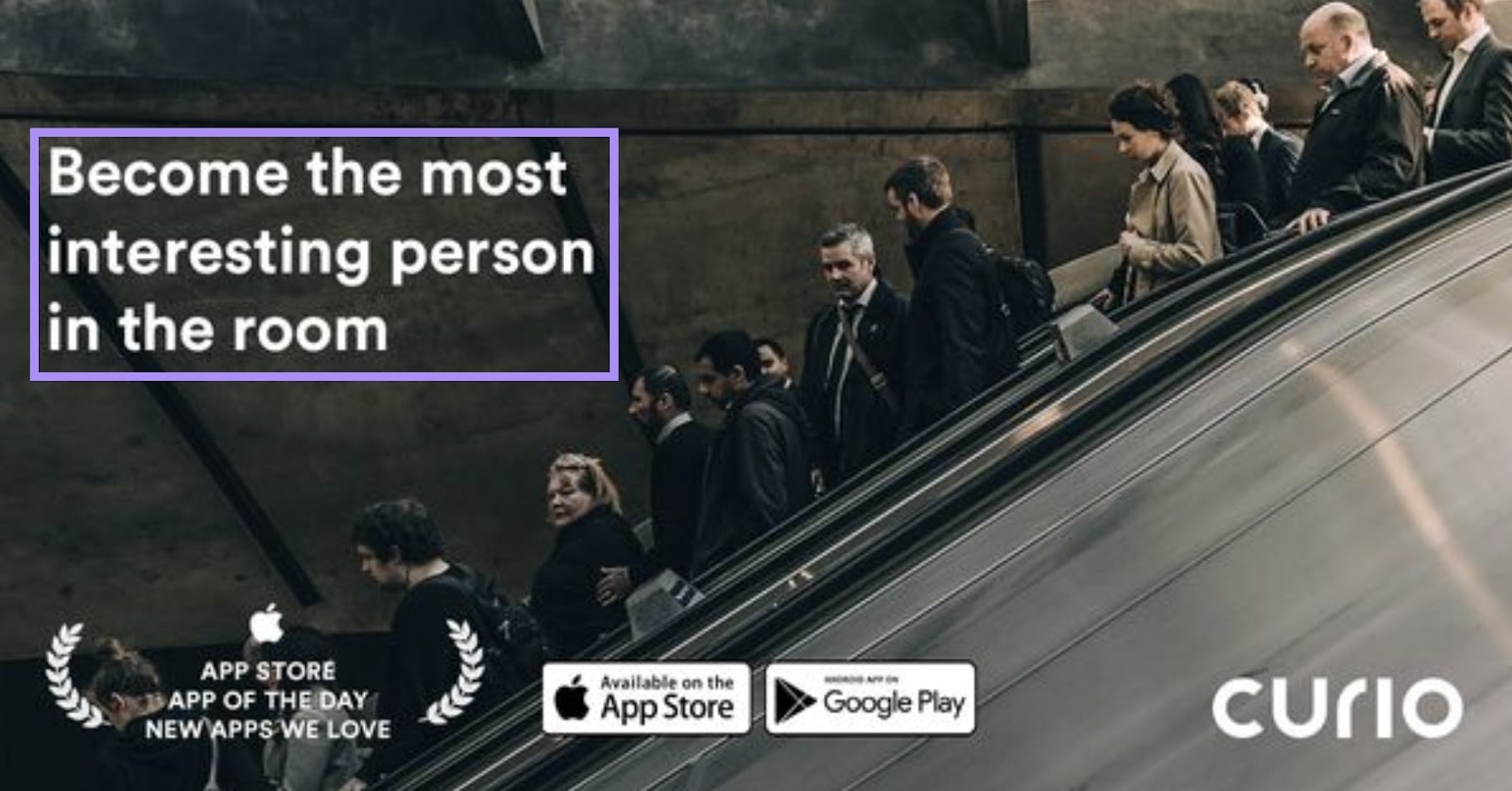
The copy appeals directly to customers’ aspirations. Curio will help you “become the most interesting person in the room.”
The addition of Apple App Store recognition gives the ad weight. But it’s the headline that tempts potential customers to act.
Why?
Because it appeals to people’s desire for status. Humans have an innate need for social validation.
We all want to be the most interesting person in the room.
To create successful ad copy, drill down into your offer. Uncover what your customers ultimately want to become or achieve.
For example:
- Curio narrates the best journalism. Why?
- So users can keep up with the world on the move. Why?
- So they’re always in the know. Why?
- So they can become the most interesting person in the room
13. Caliber: Turn Ads Into a Conversation
Conversational copy is a powerful copywriting style because it’s informal. It feels natural and not like you’re being sold to.
Workout app Caliber offers a great example of how to win over your target audience with the power of conversation. Here’s its Reddit ad:
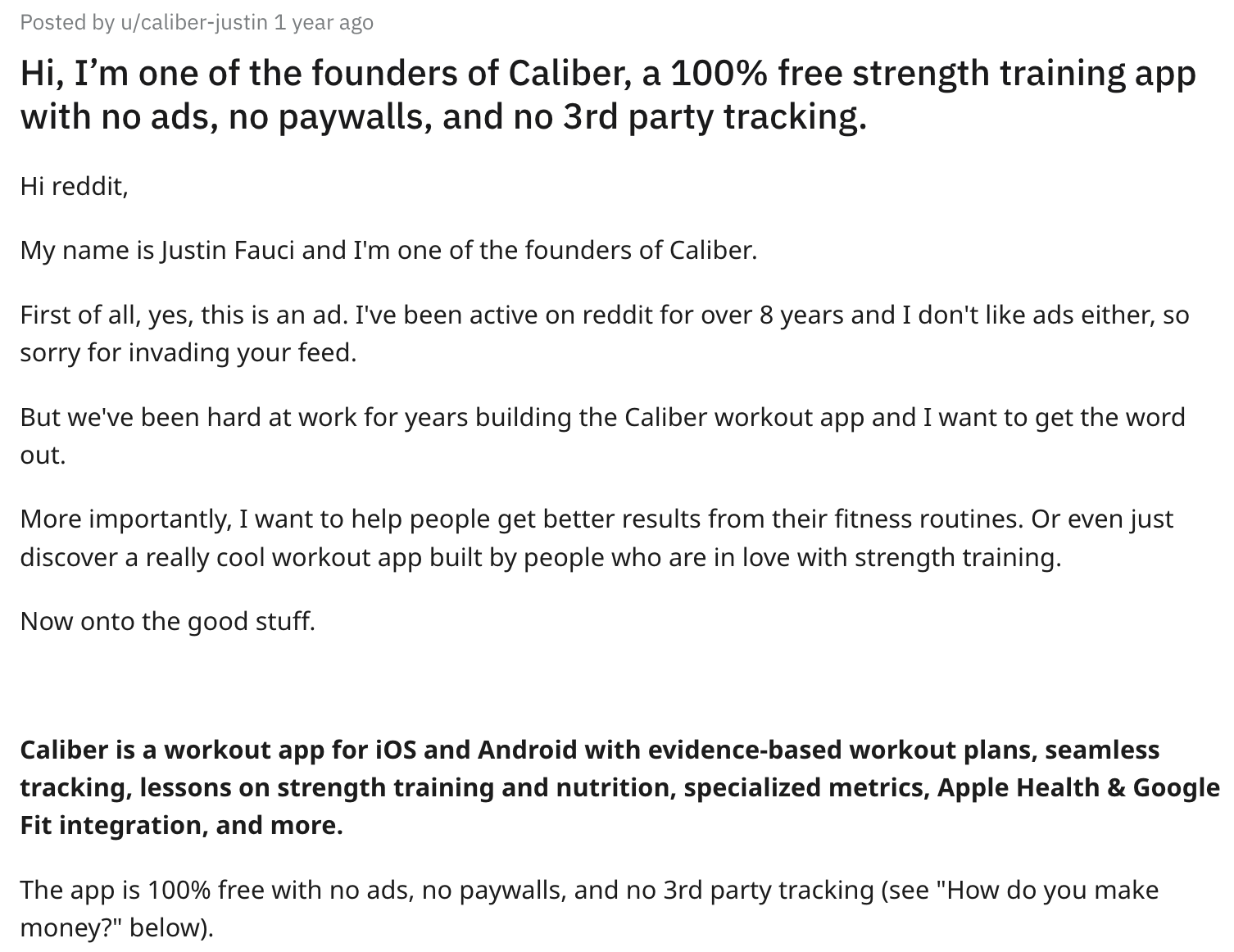
Reddit users can be a tough crowd. When growth marketing agency Ladder ran an ad experiment on the platform, it concluded that Reddit wasn’t worth pursuing.
There’s no getting around this simple truth. Reddit’s users are paranoid about ads.
That’s right: Redditors hate Reddit advertising.
Yet, Caliber’s ad got upvoted 6,200 times. Racking up over 2,600 mostly positive comments.


Here’s how:
Caliber’s ad copy example reads more like an email than a traditional short, snappy ad. But it’s the conversational approach that makes it work.
Simply put, Caliber’s ad doesn’t look like an ad.
First of all, Caliber’s founder Justin Fauci writes in the first person. Immediately making it more endearing than an ad written as a brand.
The headline also attracts attention by including benefits readers want to see.

Justin doesn’t try to pull the wool over anyone’s eyes. Instead, he calls out his ad. The fact he’s an active Reddit user softens the blow. It tells readers the ad is coming from a good place.

He also preempts common objections. Like how Caliber can be profitable when the app is free.
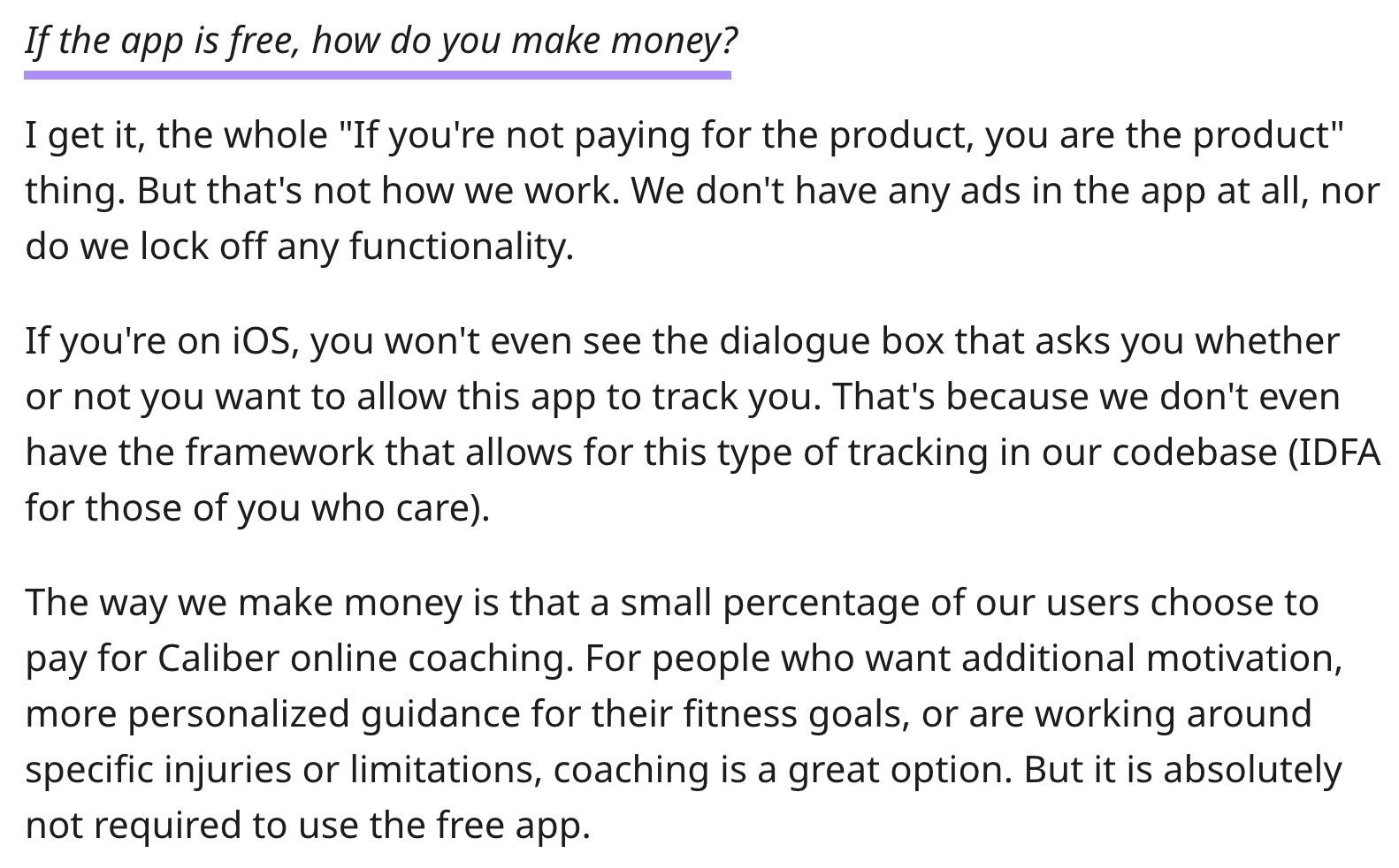
Then signs off with a non-pushy call to action (CTA) that includes an offer to help.
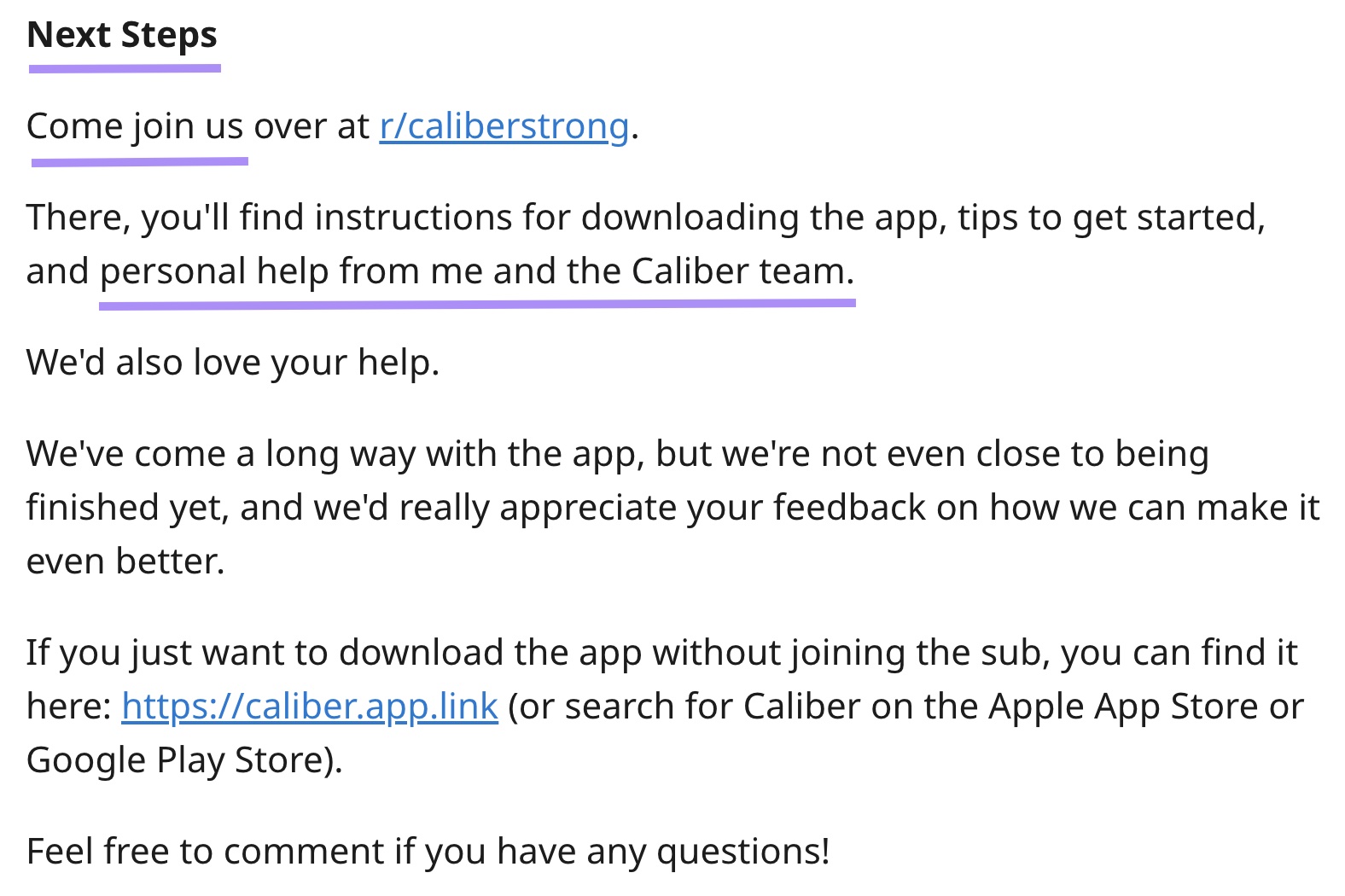
The personal approach makes Justin and his brand likable.
So what can you learn from this?
That people value honesty and transparency.
Demonstrate these qualities in your ad copywriting. You’ll build personal connections and make your ads stand out from the competition.
14. Who Gives a Crap: Create a Sense of Urgency
Adding urgency to unimportant tasks makes people more likely to perform them over more important jobs. Research published in the Journal of Consumer Research proves it.
So, if you want to increase your conversion rate, add a dose of real or implied urgency to your copy.
Who Gives a Crap’s eye-catching branding and bold personality have helped it grow from a crowdfunded toilet paper startup to a multimillion dollar company.
But beyond the fun content is a brand that knows how to sell.
The copy for its social media video ad is a textbook case study of how to use FOMO (fear of missing out) to get customers to act.
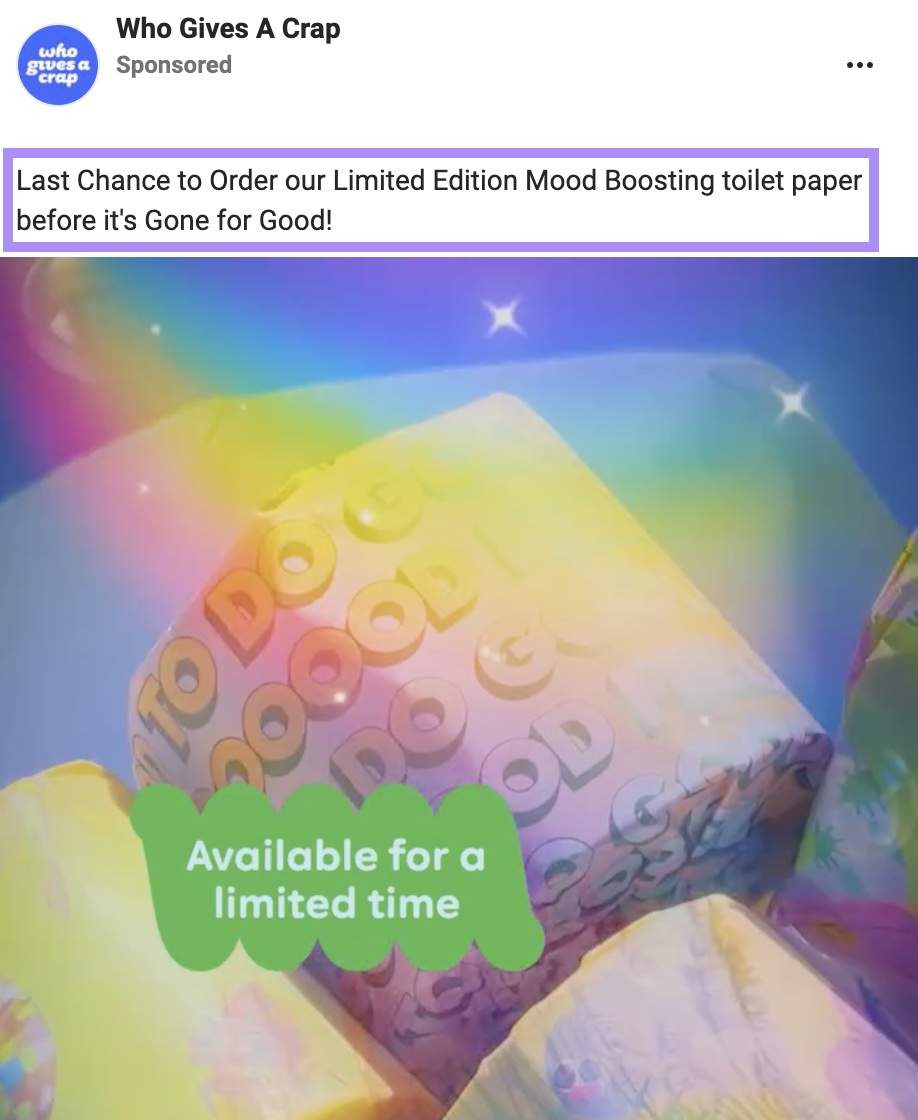
The ad copy example includes many phrases that express urgency.
- “Last Chance”
- “Limited Edition”
- “Gone for Good!”
And the CTA button follows suit.

These phrases make customers feel that the item won’t be around for long. So they need to act immediately.
Experiment with urgency in your ad copy to potentially drive a quick purchasing decision.
15. Campaign Monitor: Less Is More
Simplifying your delivery focuses your message and its impact. And just the right amount of wordplay in your ad copy can go a long way.
For instance, Campaign Monitor’s ad campaign by BarrettSF uses only homophones to sell its email marketing product.
Here’s the gist of it:
We’re all used to receiving boring emails. We either ignore or delete them. As a marketer, your goal is to create emails that make people “buy,” not say “bye.”
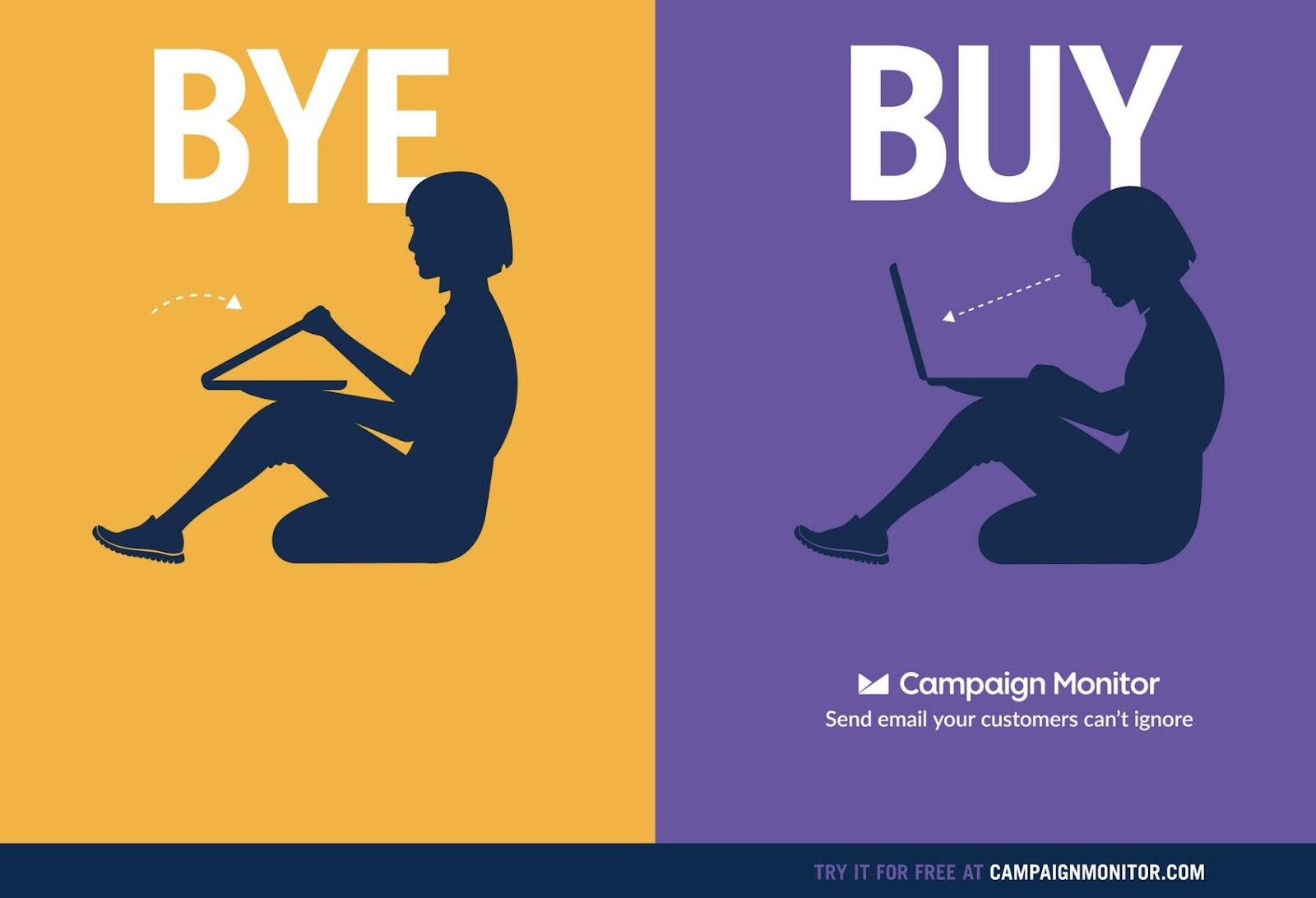
Two words that sound the same but have different meanings. Both of which sell the value of the product.
They also complement Campaign Monitor’s tagline: “Send email your customers can’t ignore.”
As clever as the copy is, it’s also important to acknowledge the art direction here.
The bold colors and contrasting images highlight the difference between the terms. And help the ad draw viewers.
16. Patagonia: Distinctiveness Is Memorable
If you want to stand out in a crowded market, do what everyone else isn’t doing.
Picture Black Friday. At a time when most brands and retailers ask you to buy, outdoor clothing brand Patagonia did the exact opposite.
Its New York Times ad showed its signature fleece under the headline “Don’t buy this jacket.”
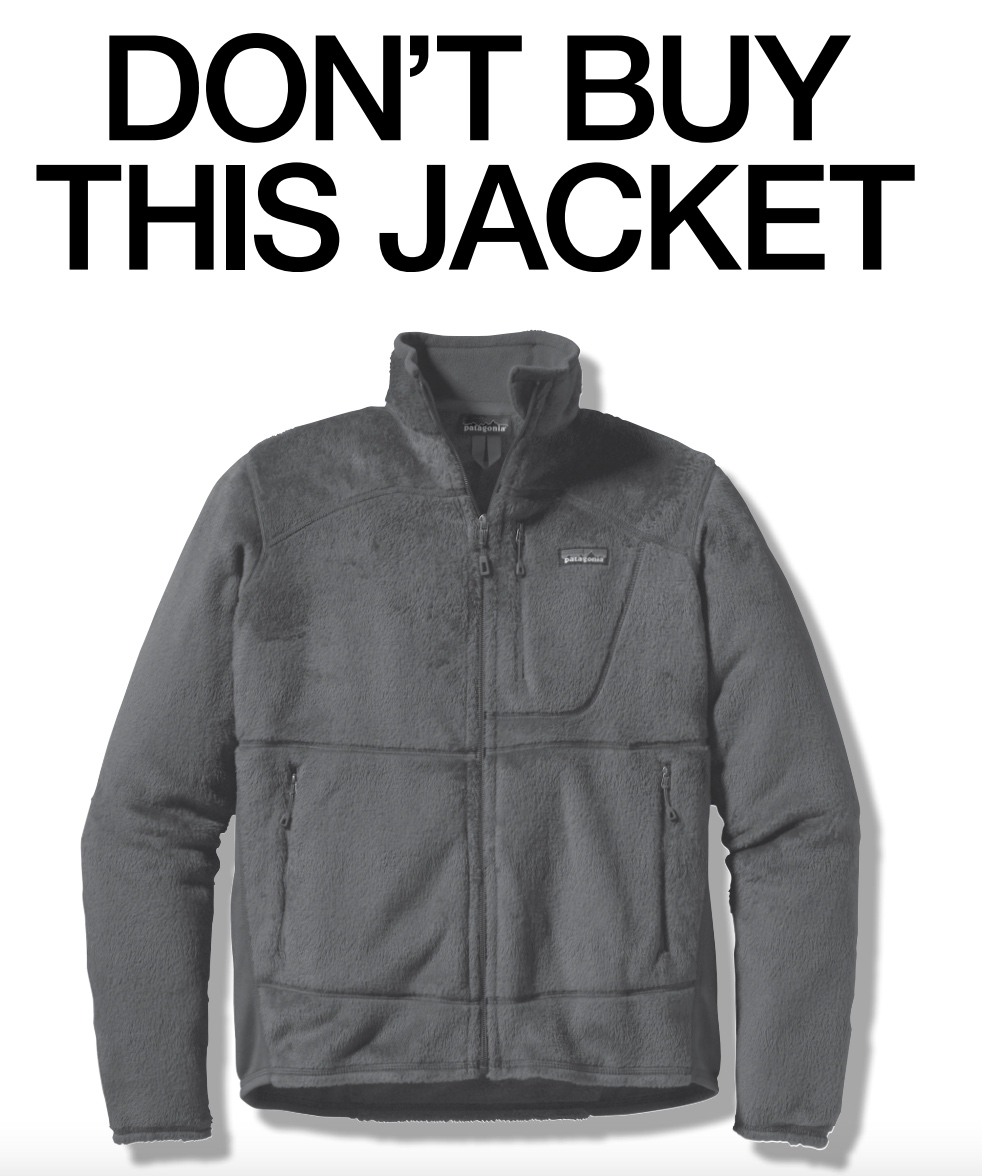
Image Source: Patagonia
Ad executive David Ogilvy said:
On the average, five times as many people read the headline as read the body copy. When you have written your headline, you have spent eighty cents out of your dollar.
In other words, spend 80% of your time nailing the headline.
Patagonia’s ad is a prime example of the importance of an attention-grabbing headline.
The “anti-marketing” approach stops you in your tracks. Because it’s the opposite of what you’re used to seeing.
The ad copy explains the meaning of the headline. It encourages people to consider the impact of Black Friday on the environment so they only purchase what they need.
But it also subtly positions Patagonia’s jacket as the best product you could choose.
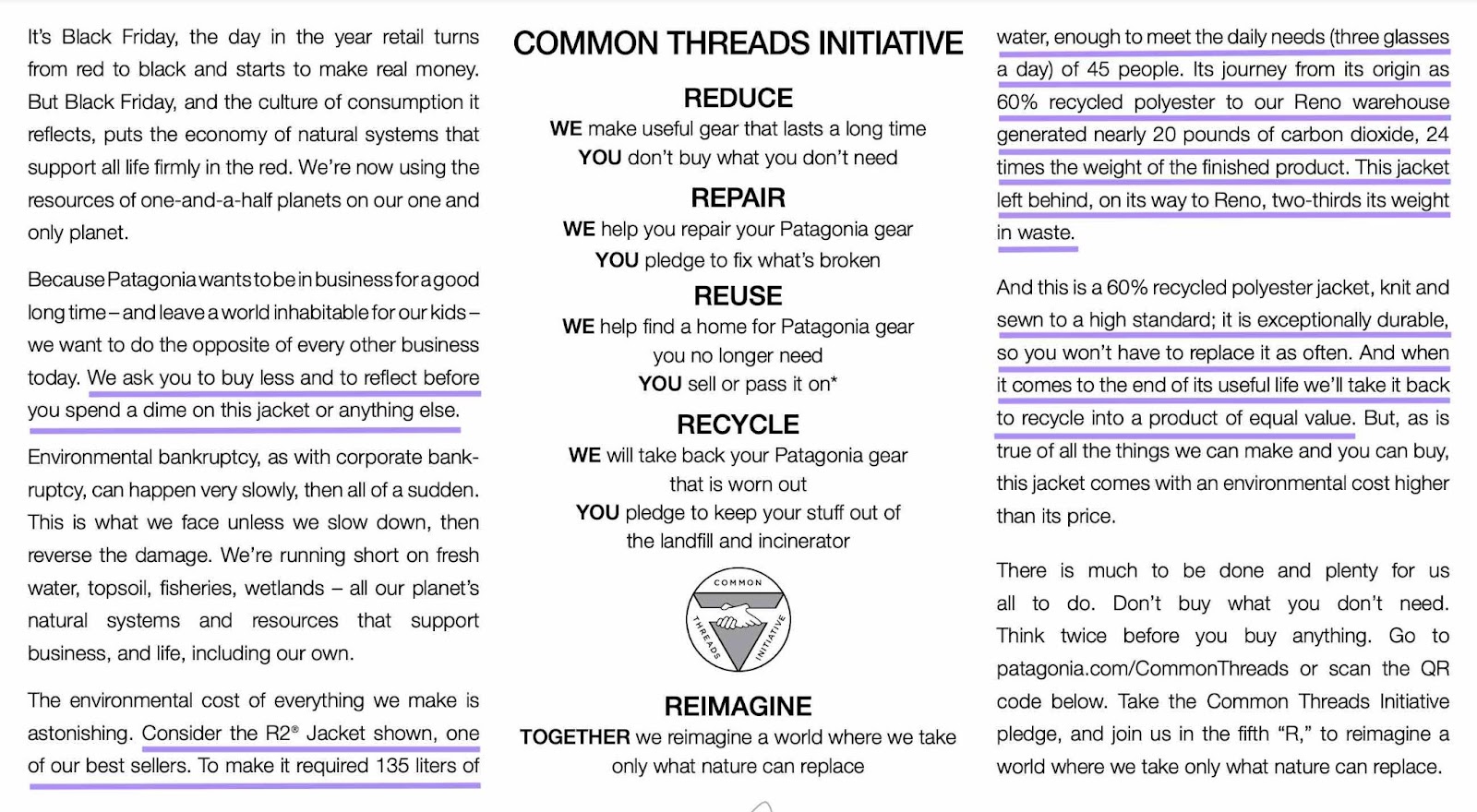
Running this type of ad is a risky strategy. A bold approach may come across as hollow if you don’t back it up.
But it worked for Patagonia because of its long track record of making good on its claims.
The company donates a percentage of sales to the preservation and restoration of natural environments. And supports grassroots organizations.
That gives the ad credibility and rallies people behind the cause. Patagonia’s sales rose by 30% in the year following the campaign.
To stand out, dare to be bold with your ad copy. But don’t do it only for effect.
Ensure your messaging stays true to your purpose and mission. Actions will always speak louder than words.
Use Semrush to Improve Your Ad Copy
The above advertising copy examples show there are different ways to get customers to act.
But remember: your target audience must be at the core of every technique, tactic, and word choice.
The best ad copy examples appeal to people’s needs and aspirations. Be relevant and helpful while staying true to your brand—and you’ll be on your way to winning new customers.
If you want an advanced AI ad copy generator and Semrush data to back you up, try Ads Launch Assistant—the platform that empowers you to manage Google and Meta ad campaigns from start to finish.
You'll get high-quality AI-generated ad copy, headlines, and UTM tags, and the choice to import keywords from Semrush databases or generate them with AI.
To get started, log in to Ads Launch Assistant and connect your Google and Meta Ad accounts.
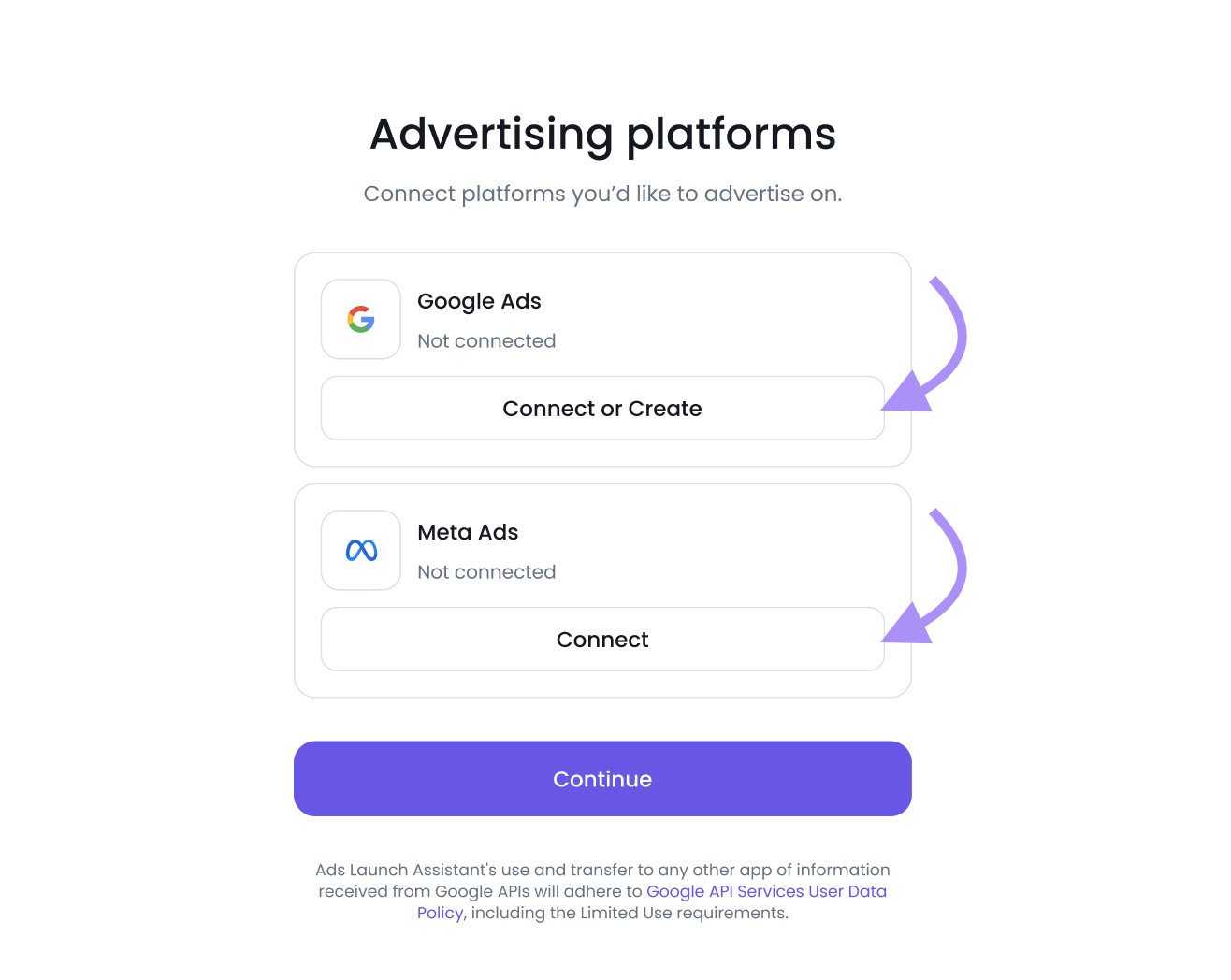
Choose the platform where you want to launch your ads, and share your business URL and additional details for advanced targeting options.
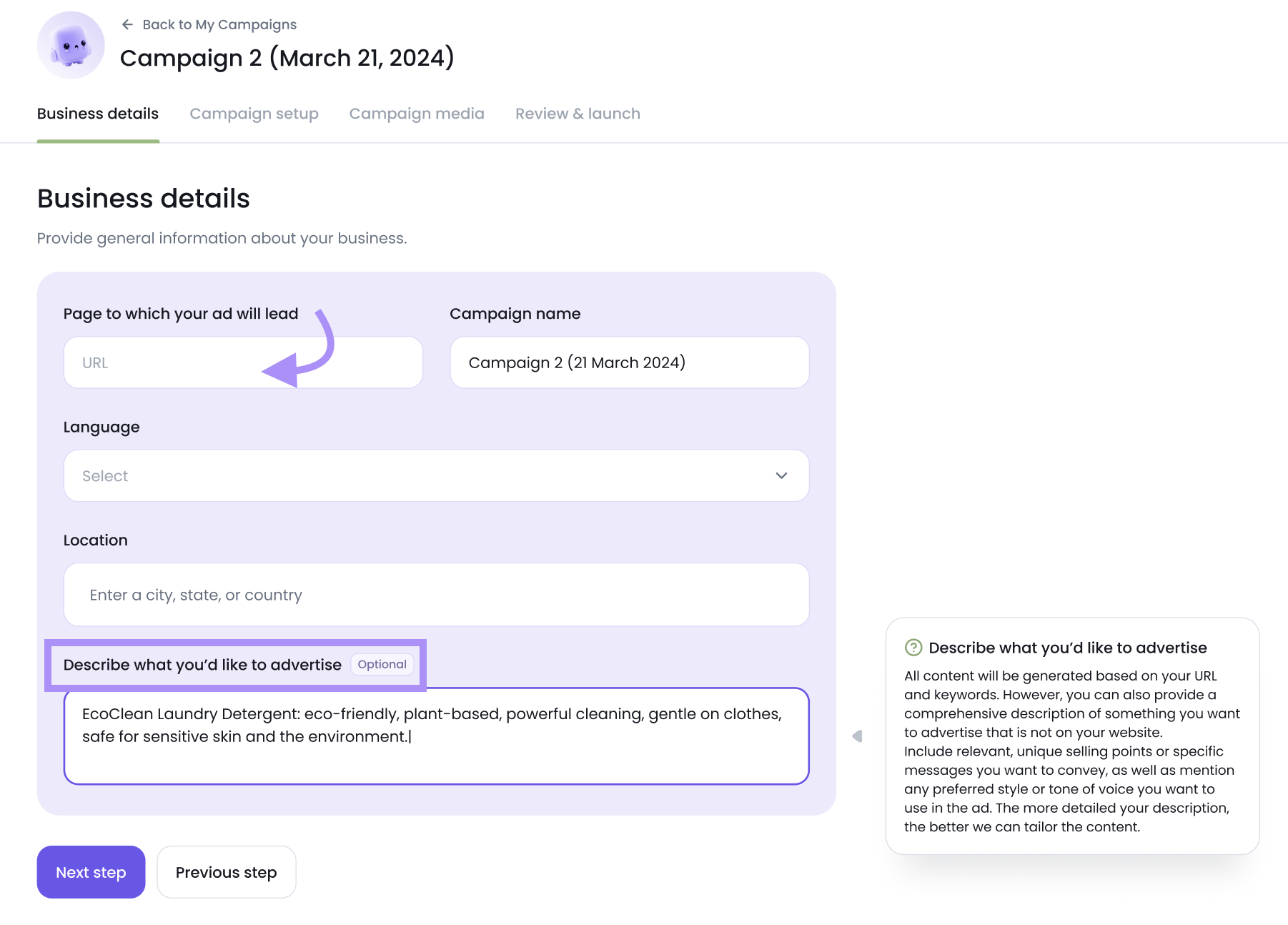
You’ll then get AI-powered ad copy and optimized keywords, tailored to your business and campaign goals.
Need more ad writing inspiration?
Use Semrush’s AdClarity Advertising Intelligence for examples and data-driven suggestions to power your copy.
